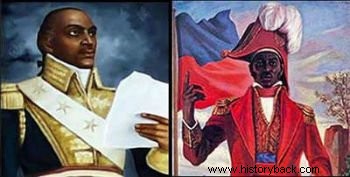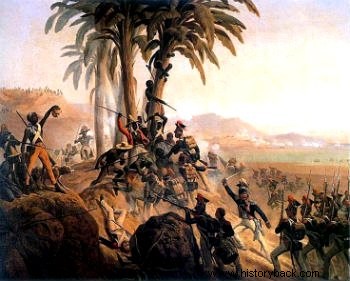The independence of Haiti was proclaimed on January 1, 1804.
Haiti was the first independent nation in the Caribbean, the first black republic in the world, and the first country in the Western Hemisphere to abolish slavery.
Abstract
The French occupied the western part of the island of Hispaniola while the Spanish occupied the eastern part.
Both, however, honored the same saint, but each in its own language:Saint-Domingue for the French, Santo Domingo for the Spaniards.
Until 1789, Saint-Domingue was the richest of the French colonies, producing 40% of the world's sugar. The monopoly was administered by 40,000 French colonists in the service of the metropolis.
Slaves, however, represented half a million people and were brutally mistreated.
They faced problems such as food shortages, had a high mortality rate and were exposed to infectious diseases
There were also almost 30,000 people of African origin who worked as domestic servants in the settlers' homes. They were a step above rural workers, as they were literate and also served in the army.

Toussaint Louverture and Jean Jacques Dessalines, leaders of Haiti's Independence
Causes
It was in this context that French farmers began to discuss the application of the principles of the French Revolution to the island's independence.
In 1791, based on the Universal Declaration of the Rights of Man and Citizen , the new French government decided to give French citizenship to every man who was free and owner, regardless of skin color.
This attitude aroused revolt in the slaves, as they hoped to gain freedom with the French Revolution. In this way, they destroyed plantations, expelled the settlers and killed those who refused to leave.
The slaves, led by François Toussaint Breda, grandson of an African chief, defeated the French and allies. He later adopted the name Toussaint L'Ouverture (overture , in French) and became the military leader of the revolution.
Toussaint L'Ouverture turned slaves into disciplined soldiers. Supported by Spanish and British troops, the war was bloody.
On August 22, 1791, a civil war begins. The following year, a third of the island was under the control of the revolutionaries and in 1793 the end of slavery was proclaimed.
Realizing they could not defeat him, the French government decided to formally abolish slavery in the colony in 1794.
However, with the rise of Napoleon Bonaparte, he decides to re-establish slavery in the colonies. The reason was simple:Bonaparte needed money to finance his armies and he wanted to build the French Empire in America.
The Constitution for Saint-Domingue was signed in 1801. However, Napoleon Bonaparte (1789-1821) sent General Charles Leclerc (1772-1802) to re-establish slavery and French law.
The French general achieves some victories and even captures Toussaint L'Ouverture and sends him prisoner to France, where he would die.
Of the 40,000 men who made up the French army, two-thirds died of yellow fever and the rest were liquidated in skirmishes.

Combat between Haitian and French troops
Consequences
The French success occurred, but it was short-lived. Now commanded by Jacques Dessalines, in January 1804, Saint-Domingue was declared an independent republic and began to use the name of indigenous Haiti.
It was the first successful slave revolt in the modern world and one of the few nations that defeated the Napoleonic army.
Freedom, however, came at a cost. In addition to agriculture collapsing from the long period of war, in 1825, Haitian rulers were forced to repair slaveholders.
The debt, of 150 million francs, was agreed in exchange for the recognition of independence by the French, which only happened in 1834.
Likewise, the revolt of black slaves against their masters shook the other colonies where there was slave labor.
The independence leaders of Spanish America were inspired by Haiti and even asked for help to fight the Spaniards.
In Brazil, for example, the Revolta dos Malês was inspired by Haitian deeds.
Curiosities
- Of the 40,000 French soldiers, only 8,000 returned home.
- The United States boycotted Haitian sugar for decades and only recognized the island's independence in 1862.
- In the days of slavery, slaves could not wear shirts that covered their chests, so that they could be identified. Currently, it is practically impossible to find a shirtless Haitian on the country's streets.
Entrance Examination Questions
1 . (UEL-2007) Jean Jaques Dessalines, one of the leaders of the Haitian revolution, declares:"I saved my homeland. I avenged America... Never again will a European colonist set foot in this territory with the title of master or of owner "
Source:DOZER, D. M. 'Latin America:a historical perspective'. Translation by Leonel ZaIIandro. Porto Alegre; Publisher Globe; Sao Paulo; Edusp, 1996.P.191,192.
Based on this statement and knowledge on the subject, it is correct to say that:
a) After independence, the rebellions made by the black and mulatto population against colonialist exploitation and the French armies were no longer part of the daily life of the Haitian population.
b) Dessalines, as a revolutionary leader, managed to promote the territorial unity of Haiti, uniting the eastern half of the island with the western part, which continued to be slave-holding.
c) Haiti's emancipation was due to the social contradictions existing in that colony and was configured in a political, economic and social movement, aiming to establish a new order on democratic bases.
d) Emancipated Haiti was led by democratic rulers, whose principles were similar to those of the French Revolution, such as liberty, equality and fraternity.
e) Blacks and mulattoes, even though they were the majority, did not have enough strength to promote emancipation due to the strategic and armament superiority of the French army.
Alternative c) The emancipation of Haiti was due to the social contradictions existing in that colony and was configured in a political, economic and social movement, aiming to establish a new order on democratic bases.
2 . (UFMG-2003)For Spanish America [and, one might add, for 19th century Brazil and the United States], Haiti was an example and a warning, observed with growing horror by both rulers and ruled.
(LYNCH, John. In:BEFHELL, Leslie (Org.). 'History of Latin America'. São Paulo:Edusp; Official State Press; Brasília:Alexandre de Gusmão Foundation, 2001. v. 3, p. 69.)
In this passage, reference is made to
a) the underdevelopment and misery of the Caribbean island, the poorest country in Latin America.
b) the breakdown of Haitian society, reinforced by constant economic turmoil.
c) the growing influence of anarchist and evolutionist ideals on the Caribbean island.
d) the island's independence process, marked by a massive uprising of black slaves.
Alternative d) The island's independence process, marked by a massive uprising of black slaves.
Learn more :
- Spanish America
- Independence of Spanish America
- End the African Slave Trade
- Bahia Conjuration
